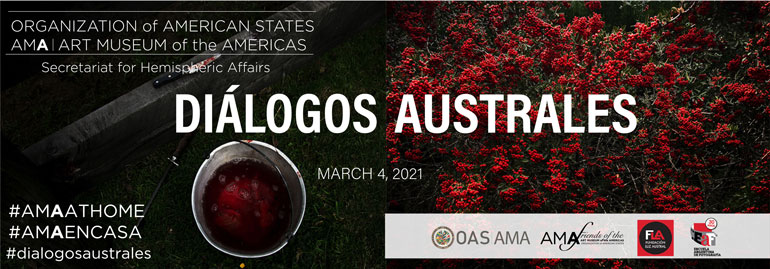Diálogos Australes / Southern Dialogs
Exhibition opening and panel, Thursday, March 4
Join us on Thursday, March 4 at 5pm EST / 7pm GMT-3 for an opening panel discussion with exhibition curators Elda Harrington and Silvia Mangialardi, and artists Maria Zorzon and Claudio Frías Beyer, and Fabian Goncalves Borrega, curator of photography, AMA.
Click here to RSVP
Inauguración de la exposición y panel, jueves 4 de marzo.
Lo invitamos el jueves 4 de marzo a las 5pm EST / 7pm GMT-3 al panel de discusión y apertura de la exposición con las curadoras Elda Harrington y Silvia Mangialardi, y los artistas María Zorzon y Claudio Frías Beyer, y Fabián Goncalves Borrega, curador de fotografía, AMA.
Haga clic aquí para confirmar su asistencia.
#AMAathome #AMAencasa #dialogosaustrales #dialogaustralis
Curated by Elda Harrington and Silvia Mangialardi, Diálogos Australes / Southern Dialogs features the work of eleven artists of Chile and Argentina who photograph what is their own: landscapes and their influence, artisanal work and trades in extinction, precarious living conditions, isolation, customs and their transmission, among other significant topics.
They now open this dialog to the world at large, which allows us to notice similarities and differences in their concerns, to take a glimpse into the relationship they maintain with art and the affinity they manifest between their reality and verisimilitude of photography, to share and compare experiences. Perhaps the approach and exchange of new ideas will facilitate a rapprochement between peoples.
Curada por Elda Harrington y Silvia Mangialardi, Diálogos Australes / Southern Dialogs presenta el trabajo de once artistas de Chile y Argentina que fotografían lo propio: paisajes y su influencia, trabajo artesanal, oficios en extinción, condiciones de vida precarias, aislamiento, costumbres y su transmisión, entre otros temas relevantes.
En este diálogo se abren al mundo en general, lo que nos permite notar similitudes y diferencias en sus inquietudes, vislumbrar la relación que mantienen con el arte y la afinidad que manifiestan entre su realidad y verosimilitud de la fotografía, para compartir y comparar experiencias. Quizás el acercamiento y el intercambio de nuevas ideas faciliten un acercamiento entre los pueblos.
List of artists / Lista de artistas:
Laura Antonelli (Argentina)
Fabián España Rivera (Chile)
Claudio Frías Beyer (Chile)
Cristhian Garabito Altamirano (Chile)
Jonaz Gómez Sánchez (Chile)
Alejandro Gulminelli (Argentina)
Alejandra Lafón Vilugrón (Chile)
Marcelo Mascareño Cortez (Chile)
Tania Morgado Jofré (Chile)
Gerardo Schachner (Argentina)
María Zorzón (Argentina)
As a way of continuing our programming while the physical space is closed in accordance with COVID-19 regulations, the OAS AMA | Art Museum of the Americas has created a new virtual exhibition program titled #AMAatHome, whose aim is to present to our audiences with the content that would otherwise be available both within and beyond the walls of the physical museum.
To this end, #AMAatHome uses four social media platforms as museum walls: Facebook, Instagram, Twitter and YouTube. The curatorial process is challenged by the limitations of each platform, and enhanced by the opportunities that are not available in the physical museum. This sort of social media exhibition allows the AMA to reach not only the audience that may visit the museum in person to the degree that they are able to, but to also reach a worldwide audience that may never enter the physical museum, whether due to geographic location, disability, or any number of other factors.
Eleven artists—Chilean and Argentinian—photograph what is their own: landscapes and their influence, artisanal work and trades in extinction, precarious living conditions, isolation, customs and their transmission, among other significant topics.
Today, from the Art Museum of the Americas, in Washington, DC, they open this dialog to the world, which allows us to notice similarities and differences in their concerns, and to take a glimpse into the relationship they maintain with art and the affinity they manifest between their reality and verisimilitude of photography, to share and compare experiences. Perhaps the approach and exchange of new ideas will facilitate a rapprochement between peoples.
Alejandra Lafón portrays the beauty and vulnerability of the ecosystems of western North Patagonia, which, due to their extreme climate and lack of accessibility, still have a very low population density. It is about the tenacity to survive in spite of snow, great fires, deforestation and pollution.
For her part, Laura Antonelli focuses on beauty, but with lush spaces, almost impenetrable, delving into the mystery of the desire to live adapting to multiple adversities. Alejandro Gulminelli transmits the pristine nature of nature as “timeless,” in a call to care for the natural habitat.
Cristian Garabito exposes the trades that resist, by choice or by necessity. He shows men and women who repeat what they learned as children without working hours, with no retirement, nor a Christmas box in December. There are no marches or demonstrations there. There is a big question: how much will the price of their work go down?
Meanwhile, Tania Morgado investigates artisanal fishing, a trade inevitably linked to nature and which, due to political and social circumstances, is disappearing. Families move far from the sea, leaving only traces of what was once a natural way of subsistence in Aysén. They mark something that certainly deserves everyone's attention to alleviate some of the unwanted consequences of progress. In turn, Jonaz Gomez builds a record of daily life in the countryside, which transits between life and death, between blood and soil. It is a tribute to the contribution of the country people who have done so much to populate Patagonia.
Claudio Frías describes the distant and inhospitable Western Patagonia and the strength of its inhabitants, their customs and their festivals, while Marcelo Mascareño reveals the struggle to keep traditions afloat through the transfer of knowledge, from generation to generation, necessary for life and to maintain identity south of the Baker River.
Gerardo Schachner recounts the migration of men and animals, during the summer, in search of the high pastures, leaving the valleys where they were protected during the winter, inevitable for the inhabitants of western Neuquén in Argentine Patagonia.
Fabián España presents a unique and unknown vision of Chile as a reflection on how difficulties mark and strengthen us. His photographs of the Region of Aysén, in Chilean Patagonia, over several years mark their transition from childhood to adolescence and into adulthood.
Meanwhile, María Zorzon celebrates the life of the people on the Argentine plain, because it is in the peasant culture where she finds the foundations of the person who she is.
Both Españ and Zorzon hint that we are very much of the culture we come from.
This exhibition is an invitation to explore the internal and external landscapes, along the Southern Cone, on both sides of the mountain range.
Elda Harrington and Silvia Mangialardi
Luz Austral Foundation
Diálogos Australes
Once artistas -chilenos y argentinos- fotografían lo que les es propio: los paisajes y su influencia, el trabajo artesanal y los oficios en extinción, las condiciones de vida precaria, el aislamiento, las costumbres y su transmisión, entre otros temas significativos.
Hoy, desde el Museo de las Américas, en Washington, abren este diálogo al mundo, lo que permite notar similitudes y diferencias en sus preocupaciones e inquietudes, vislumbrar la relación que mantienen con el arte y la afinidad que manifiestan entre su realidad y la verosimilitud de la fotografía, compartir y comparar experiencias. Tal vez el planteamiento e intercambio de nuevas ideas facilitará una aproximación entre los pueblos.
Alejandra Lafón retrata la belleza y la vulnerabilidad de los ecosistemas de la Nor Patagonia occidental que, por su clima extremo y carencias de accesibilidad, aún poseen muy baja densidad poblacional. Se trata de la tenacidad en sobrevivir pese a la
nieve, a los grandes incendios, a la deforestación y a la contaminación.
Por su parte, Laura Antonelli se focaliza en la belleza, pero de espacios frondosos, casi
impenetrables, ahondando en el misterio del deseo de vivir adaptándose a las
múltiples adversidades. Alejandro Gulminelli transmite lo prístino de la naturaleza como “sin tiempo”. Un llamado al cuidado del hábitat natural.
Cristian Garabito expone los oficios que resisten, por opción o por necesidad. Muestra hombres y mujeres que repiten lo que aprendieron desde niños sin horario laboral, ni jubilación, ni cajita navideña en diciembre. Allí no hay marchas ni manifestaciones, existe un gran interrogante: ¿hasta cuánto bajará el precio de su trabajo?
Mientras tanto, Tania Morgado indaga en la pesca artesanal, un oficio inevitablemente ligado a la naturaleza y que, por circunstancias políticas y sociales está desapareciendo. Las familias se trasladan lejos del mar, y quedan solo rastros de lo que una vez fue un modo natural de subsistencia en Aysén. Marcan algo que sin duda merece la atención de todos para paliar algunas de las consecuencias indeseadas del progreso. A su vez, Jonaz Gomez construye un registro de la cotidianeidad en el campo, que transita entre la vida y la muerte, entre la sangre y la tierra. Es un homenaje al aporte de la gente de campo que tanto ha hecho para poblar la Patagonia
Claudio Frías describe la lejana e inhóspita Patagonia Occidental y la fuerza de sus habitantes, sus costumbres y sus fiestas, al tiempo que Marcelo Mascareño revela la lucha por mantener a flote las tradiciones a través del traspaso de conocimiento, de generación en generación, necesario para vivir y mantener la identidad al sur del rio Baker.
Gerardo Schachner relata la migración de hombres y animales, durante el verano, en busca de los pastos de altura, dejando los valles donde se protegieron durante el invierno, inevitable para los pobladores del oeste de Neuquén en la Patagonia Argentina.
Fabián España presenta una visión única y desconocida de Chile como una reflexión sobre cómo las dificultades nos marcan y nos fortalecen. Sus fotografías de la
Región de Aysén, en la Patagonia Chilena, a lo largo de varios años marcan su tránsito de la niñez a la adolescencia y hacia la adultez.
En tanto María Zorzón celebra la vida de la gente sobre la llanura argentina, porque es en la cultura campesina donde encuentra los cimientos de la persona que es.
Ambos haciendo alusión a que somos mucho de la cultura de la que venimos.
Una invitación a recorrer los paisajes internos y externos, en el Cono Sur, a ambos lados de la cordillera.
Elda Harrington y Silvia Mangialardi
Fundación Luz Austral






